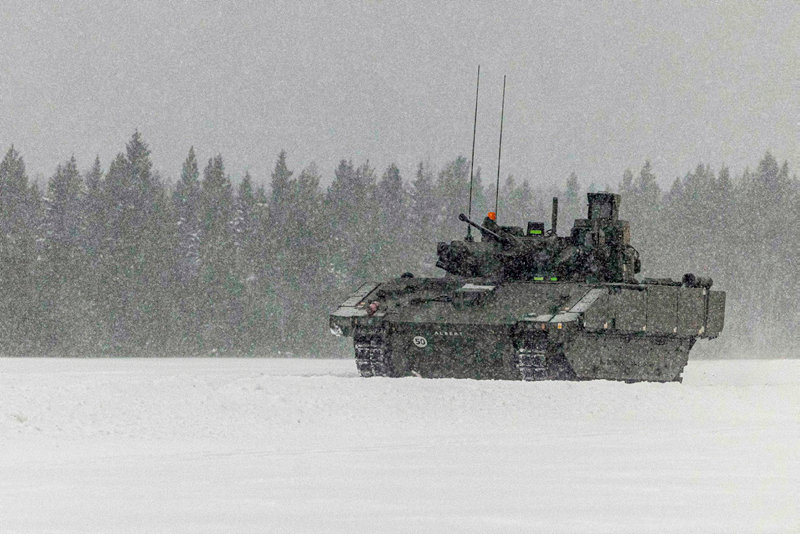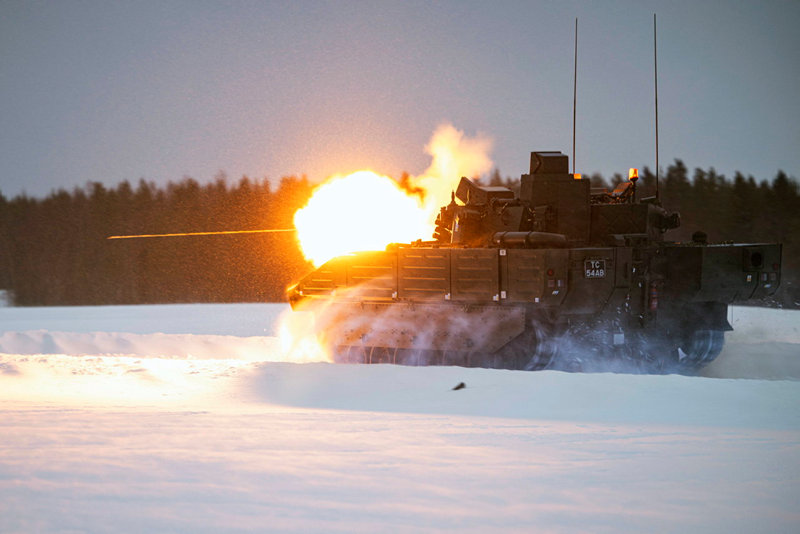British Army conducts Ajax subarctic trials
Courtesy British Army
Service personnel from the Household Cavalry Regiment (HCR) based in Bulford, Wiltshire have successfully demonstrated the Ajax platform’s capability to operate in extreme cold weather, and fire on the move with accuracy.

Tests were carried out in the punishing, wintry conditions of frozen Lapland where temperatures regularly dropped to minus 30 Celsius.
Major Robert Gardner, Ajax Trials and Capability Development, said: “We were aiming to prove that Ajax works as effectively in these conditions as it does in a temperate climate, therefore allowing it to be deployable all over the world.
“The live crew clearance showed that the turret is safe to use and also demonstrated we lost no lethality or effectiveness whilst operating at extremely low temperatures.”
The HCR soldiers from the Regiment’s armoured reconnaissance unit marked a significant milestone during the overseas tests, becoming the first Field Army crew to fire the Ajax at home or abroad.
“These trials are a continuation from those that took place recently in the UK”, said Major Gardner “The tests have advanced from crews that have not fired the vehicle, to ‘static versus static’, firing approximately 120 rounds, moving on to ‘static versus moving’ and then finally proving ‘moving versus static’ whilst out here on the range in Tåme.”
“Firing on the move has been really successful. It has also proven the progression from doing absolutely no firing to building up that crew confidence and getting to a point where they can achieve those activities.”
For Lance Corporal Alex, Macdonald, an Ajax gunner, this has been the first opportunity ‘to get hands on experience,’ prior to Sweden his training was mainly on simulators.
He said: “Being one of a handful of people to fire this in the Army is pretty good. It has been great, one of the best things I’ve done in my career and my training paid off and gave me confidence in the turret.
“Arriving in Swedish Lapland to temperatures of minus 38C, was a bit of a shock but the heating inside these vehicles managed to keep us warm once we got to work.
“This climate obviously comes with its own problems”, he added “but the weapon systems have performed better than we thought they would. There were a few teething issues, which we were expecting with it being a new vehicle but overall, it has been positive, with some really valuable feedback. The next challenge is to learn to use the vehicle more, it will only improve as we improve.”
Working in the subarctic was demanding for man and machine, as driver, Trooper Reuben Burt, who has worked on the vehicle for five months, explained: “Doing a maintenance job, especially getting under them and laying in the snow was pretty rough.
“We’ve learnt that the rubber track pads are not good on snow, as they caused sliding and drifting but it’s about pushing the vehicles to see how they cope, testing the vehicle to its limit.
“Compared to the Warrior Infantry Fighting Vehicle, it feels more modern. My Troop Leader described it ‘like going from analogue to digital or driving a sports car with a manual gear box, to driving a new Ferrari racing car.’
“The engine just feels better underneath you, the steering handles better, it’s a bit bigger but, it’s been a pretty capable vehicle.”
This cold weather trial has been an excellent opportunity for the Army to really get to grips with Ajax and test and understand its capability.

The combat vehicle’s mobility over difficult terrain and its high standard of protection, Intelligence, Surveillance, Target Acquisition and Reconnaissance (ISTAR) will provide a world leading competitive advantage.
Major Robert Gardner concluded that ‘over the trial Ajax demonstrated itself to be very effective in this environment’, he said: “We’ve seen no drop in its effectiveness compared to those in the UK, which is really positive. And now we’ve proved the cold climate, the next step is to prove it in the hot weather this summer and at that point it is essentially proven and deployable in all situations.”
“Ajax is a complete and utter step change, compared to a Combat Vehicle Reconnaissance (Tracked) (CVR T) both mobility, lethality and also its ISTAR capabilities are far beyond what we have had previously.”
DE&S
Members of the Defence Equipment & Support (DE&S) Ajax delivery team worked with the British Army Household Cavalry Regiment (HCR) to put Ajax through its paces in sub-zero temperatures in Sweden.
One of the key DE&S personnel at the cold weather trials in Tåme was Warrant Officer Class Two (WO2) Paul Martin, who is the Range Conducting Officer and ran the range and firing serials in Sweden, as he does in the UK.
WO2 Martin said: “It was great to work alongside our Army colleagues and industry who all have one common purpose and that’s the end goal of delivering this exceptional platform to the Field Army,”
“It was an extremely challenging environment but working as a group we were able to successfully deliver our objective of demonstrating that Ajax can travel long distances over snow-covered terrain and fire on the move with great accuracy.
“Ultimately, Ajax exceeded our expectations and the exceptional work across the group saw us gather more data than expected which will inform the wider team and help them understand exactly what this exciting platform can do.”
Also present in Tåme was Lieutenant Colonel James Glossop, the DE&S delivery team’s Operation and Army HQ liaison. Lt Col Glossop said: “It was very impressive to see Ajax perform in Sweden. I was lucky enough to see the platforms fire during a snowstorm and use its sighting systems to identify, engage and hit targets that were simply unable to be seen by the naked eye. It was incredibly impressive and a reminder of the competitive edge this armoured vehicle will bring the British Army.”












